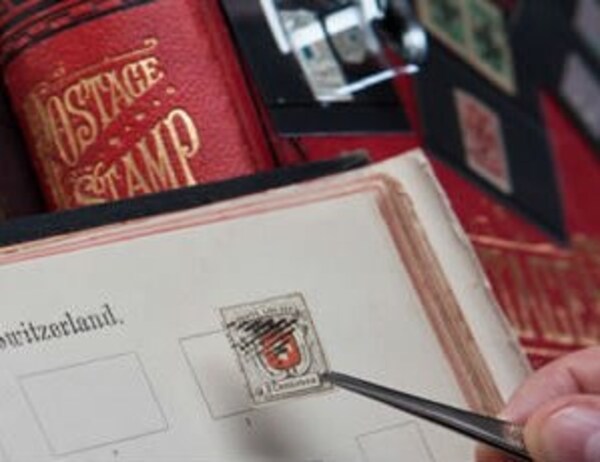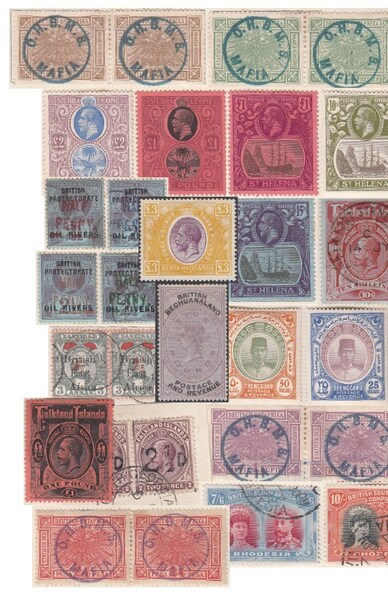Catalogue versus Website
Philatelic auctions have been around for almost 140 years, in fact since 19 December 1865 when the stock of the dealer J.W. Elb came under the hammer at the Hotel Drouot in Paris. Although the sale was well attended by dealers and prominent collectors of the period, the total realised was a mere 800 francs. Not surprisingly, a further five years passed before the experiment was repeated.
In May 1870, J. Walter Scott, the leading American dealer (and founding publisher of the world-famous Scott catalogues and stamp magazine, still going strong), organised the first stamp auction in New York. Again, the sale was something of a social occasion and everybody who was anyone in the stamp world was in the room. Like the Elb sale, the results were paltry, the total barely reaching $500. Successful bidders got some fantastic bargains, such as a Hawaiian Missionary 5 cents for a mere $11 and an entire collection of 1800 stamps in a Moens printed album for $38.
Nothing daunted, Scott persevered with stamp auctions and gradually they gained acceptance. In 1872 he even crossed the Atlantic and masterminded the first stamp sale conducted by Messrs Sotheby, Wilkinson and Hodge in London which achieved a total of £253 ($1,250 at the prevailing exchange rate), a world record. The results would have been a lot better had some of the prominent collectors not sat on their hands when they realised that Scott himself was bidding in an attempt to force up the prices!
By the 1890s, however, stamp auctions were well established and both vendors and bidders were confident that this medium offered them the best deal. Auction catalogues were slim brochures, devoid of illustration, and extremely modest compared with the catalogues of the present day. Even sales of the really great collections were accompanied by catalogues which seldom included illustrations and it was not until the 1950s that pictures of the more important items began to appear, in black and white.
The catalogues of the present day are a far cry from those of even 20 years ago, with a much greater emphasis nowadays on colour illustrations, and better descriptions in general. At their best, catalogues may be regarded as reference works of permanent value and, indeed, the catalogues of the great 'named' sales eventually become collector's pieces in their own right.
There are many collectors who still prefer to bid at auction in the traditional manner. There is, perhaps, a psychological aspect to this. There is undeniably something satisfying about the latest catalogue coming through the letter-box, to be perused at your leisure, the lots compared against items in your collection or noted against your wants list. In a relatively leisurely fashion you make up your mind which lots you would like, you fill up the bid form and send it off by post or fax to the auctioneer, then sit back and wait for the results.
It is no exaggeration to state that we are living through one of the greatest revolutions to hit mankind. The Communications Revolution has far wider implications than the Industrial Revolution of the late-18th and early 19th centuries. Of course, if you are reading this, you are one of those who have already embraced the new technology, but it has been projected that within five years most households will have at least one PC and that computers will be as commonplace as radios or television sets are today. Already the way we communicate has been revolutionised and changed out of all recognition, and we now have the facility to talk for hours to people on the far side of the globe for a fraction of the cost of a local telephone call a few years ago, and in many cases to view live pictures simultaneously.
Who, five years ago, would have thought that all this would be possible, let alone something we now take for granted? People who wrote letters to each other once or twice a year now communicate on a daily basis by e-mail, but perhaps the greatest quantum leap has been in the ability to shop on-line. E-commerce is still relatively in its infancy but it is surging ahead by leaps and bounds.
Undoubtedly the buying and selling of stamps and postal history material is benefiting from the Internet. There is, of course, the speed with which we can communicate, sending and receiving messages in the twinkling of an eye, but a well-run, highly organised website, such as this one, affords limitless opportunities, enabling vendors to offer their material with ease and bidders to buy with confidence. Certainly the Internet has benefited philately immensely. Quite apart from the ease of bidding on-line, and the speed at which transactions can be effected, the salient advantage of website auctions as far as bidders are concerned is the ability to view stamps.
Of course, you can look at illustrations in a printed catalogue but the images will be rather small and it will not be possible to illustrate everything. By browsing through the auctions on-line, however, you can click on thumbnails and see stamps larger than life. Any imperfections, such as pulled perforations or heavy cancellations, are immediately perceived.
A printed catalogue has the disadvantage of being fixed, its parameters set by the limitations of having to set and print pages in a prescribed manner, but with a website catalogue you have a multi-layered, multi-dimensional reference tool that enables you to access general lots by value, country lots in alphabetical order, or different topics and categories likewise arranged from A to Z. In the case of British material, which tends to figure prominently, you can even access lots in chronological sequence. These additional features makes the website catalogue infinitely more user-friendly than the traditional printed catalogue.
The day may not be far off before printed catalogues are dispensed with altogether. Certainly the spread of computers around the world is leading to a paperless society where we need no longer visit our friendly neighbourhood public library - powerful search engines bring all the knowledge and information of mankind to us in seconds. Some day, in the not too distant future, on-line shopping for everything under the sun will be as commonplace as going down to the local supermarket is today. And in the realm of the philatelic auction, it is likely that most sales, and certainly those like Sandafayre which are conducted on mail-order principles, will be more and more geared up to the Internet.
Sandafayre is already the world's largest postal stamp auction company, and we are confident that within a year or two it will also be the largest philatelic auction available on the Internet. The immense strides in the computerisation of lotting and describing material means a faster turn around for the vendor, but it also accelerates the process of bidding and eliminates the many human factors which, in traditional auctions could give rise to purchasers getting the wrong lots, or being incorrectly billed. The much greater use of credit cards has also simplified billing procedures, to the benefit of the customer, although we still have the proviso to accept cash or cheques. Certainly for overseas clients, credit cards have proved as revolutionary as the Internet itself in making transactions immeasurably simpler and faster - and every bit as secure as traditional banking procedures.
Take a few moments to study the Help section of our website, to familiarise yourself with our terms and conditions, and tips on how to search and how to bid. Don't forget to check out the various features and screen and last, but not least, the pointers that deal with trouble-shooting. If you have been content to bid via the printed catalogue until now, you will be very pleasantly surprised when you click on to our website catalogue and find how simple and helpful this method is.
Join the Revolution!

 General
General
 General
General
 General
General